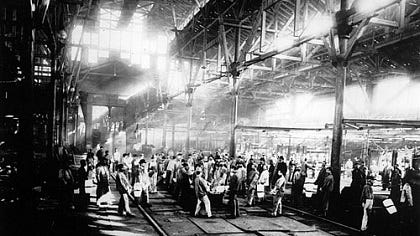Entities in the Intelligence Age: Redefining the Foundations of Innovation and Economic Growth
The frontier is not compute alone, its Organisation.
It's an easy belief and myth that technology alone propels us forward - unfortunately it's much harder than that. History is not written by steel, guns and gems alone, but by societal structures that allow us to collaborate in direct and abstract ways.
Recall your first venture—when you launched a startup, you had to set the rules: who leads, how profits are shared, and who manages key tasks. These simple agreements laid the foundation for modern legal entities that business in all our economies worldwide. Now, zoom out: the Golden Gate Bridge. Could a single genius inventor build it? No. It needed a specific entity, a structure to organize engineers, finances, and legal frameworks. In this example it was ‘The Golden Gate Bridge and Highway District’, empowered to issue bonds to gather finances and manage across multiple counties. Entities, not just blueprints, make grand achievements possible. The result: The Golden Gate Bridge was built in just 5 years - that's faster than most bus stops today in Europe.
Consider 1870s Germany. The steam engine existed for decades, but Germany's "Gründerzeit" boom wasn't about steam. It was fueled by new business entities (AG & GmbH) that allowed access to new finances and new liability absorption, a unified market, and new visas that allowed top talent and engineers to flock towards newly generated companies from all over Europe. Innovation existed, but entities unlocked prosperity by allowing a new level of organization of many around the ambitions of a few. Rules of the game matter more than just having the newest toy.
Even our trust in money, stocks, or even crypto addresses rests on entities. We believe in the system, in the frameworks that govern them - and that they even transcend borders and nations. Consider the British East India Company. Chartered in 1600 as one of the earliest joint‑stock companies, it unified fragmented, state‑based trading systems. By the mid‑18th century, the Company controlled nearly 40% of trade between Britain and Asia, with annual revenues estimated to exceed £15 million—a staggering sum that, in today’s money, would amount to billions. This legal innovation enabled investors across different states to pool capital and share risk, reducing fragmentation and unleashing economic momentum on a global scale.
Entities are the overlooked heroes of progress. Technology is just a tool; entities are the hands that wield it effectively. Governance isn't a burden; it's the framework for competition and progress. Entities aren't roadblocks; they are the very foundation of how we organize to build the future. And in this context, intelligent regulations is not red-tape fetishism; it is the standardisation of interfaces, that allow for scaled collaboration.
For millenniums, entities have been the building blocks of economies, the "Legos" of global trade. From Roman "societas" to today's Delaware C-corps, they define collaboration, incentives, and risk management. Entities are the containers for ambition, resources, and teamwork, turning them into economic results – and in recent times, technological leaps.
Look at the success of today's Delaware Inc. It’s a bigger US export than burgers or oil. Why? Not because it's packed with features, but because it's reliable and globally integrated. Fortune 500s flock there. Y-Combinator, a startup powerhouse, insists its companies incorporate in Delaware - even while operating mainly in California, a different state. Startups like Airbnb, Stripe, and Reddit – giants built on this entity framework. Yet, Delaware Inc. isn't perfect; it's just the best available, not necessarily the perfect. Imagine entities specifically designed for today's challenges and opportunities, not just yesterday's.
Entities do also shape innovation itself. They dictate how and where ideas scale and how adaptable economies become. If markets are an invisible hand, entities are the gloves, providing the grip to shape national outcomes. This isn't a new idea, but it's been lost in policy discussions.
In a tech-driven world, winning entities attract global finance, talent, and distribution. That's why eight of the top ten companies are Delaware-incorporated, VC-backed tech giants, leaving Europe behind. Nvidia’s explosive growth, reaching a $3.43 trillion valuation in 2024, underscores this shift. A new resource is in demand: "floating points & thinking sand" – intelligence, organized by brilliant minds, powering the world.
In the last 150 years, the world transformed. But entities remained largely unchanged. The UK Ltd. in 1856, German GmbH in 1892, Delaware's rise in the early 1900s – these are old models. Even the LLC and PC in the 60s and 70s were fundamentally similar. In an age craving innovation, the very structures that foster it are stagnant.
Historically, entities adapted to the dominant resource. Agrarian societies thrived with simple entities suited for land management. The Industrial Revolution birthed corporations, unlocking capital markets and fueling growth. In 1871, German joint-stock companies sparked a boom, creating giants like Mercedes-Benz. The service economy saw the rise of LLCs, offering flexibility for complex collaborations. By 2019, millions of LLCs existed in the US, vital for service-based economies.
But today, these structures falter. Digital platforms, e-commerce, the gig economy – they strain against old entity models. Tax loopholes like the "Dutch Sandwich," (a prominent tax evasion schemes for Big Tech operation in Europe) content copyright battles, and the massive AI data grab by nonprofits highlight the mismatch. A nonprofit copying the internet to fuel AI, then paywalling it for billions – this shows how value is shifting. Yesterday's clickbait is today's AI fuel, and there is nothing bad around it but capitalism evolves much faster than the OS it is operating on.
Accepting that entities adapted to the dominant resources of its time, there’s a huge opportunity on the horizon: to redesign entities for the incoming intelligence age - as declared by Sam Altman, founder of OpenAI. For founders, policymakers, politicians – entities are overdue for an update. To stay competitive, economies need entities that harness today's dominant resource: intelligence.
This new dominant resource is potentially more diffuse than simple labour or land —Think about your own brain. One exaflop of computing power, sitting right there. Globally, human brains dwarf artificial computing. Yet, are we truly using this intelligence? Often, we treat people like floppy disks, not exaflop brains.
The intelligence age demands new questions, not just answers. Entities need to foster experimentation, risk-taking, and rapid adaptation. Imagine an even more radical "EU Inc." – fluid, agile because component based, optimized for AI-integrated work, constantly evolving as collaborative open source protocol on firm fundamentals, seeking new frontiers. This shift is faster and more disruptive than ever. "Hyper Moore's Law" – AI accelerating AI - was proclaimed by Jensen Huang in the end of 2024 and will leave us in awe on the progress of opportunity for prosperity. In this new landscape, economies mired in outdated hierarchies will crumble, while visionary organizations that reinvent the rules of engagement will command the future of prosperity.
AI itself is part of this optimization. AI optimizes logistics, energy grids, finance, and even social interactions, creating a feedback loop of accelerating progress. AI reshaped media and finance. Legacy companies struggle. AI will impact every industry, demanding new ways to organize work, resources, and value.
The intelligence age isn't about internal solutions to old problems. It's about entities that generate new problems and explore uncharted territory. Dynamic systems, adaptability, learning are key. Success won’t originate out of just individual brilliance, but collective intelligence, that is able to produce more problems and opportunities to AI to work on. The problem itself will become the fuel of economies. The intelligence age will be explosive, unpredictable, and transformative.
We can automate work with intelligent systems on scale. But how many entities truly leverage intelligence – human or AI - to really leave a dent? How many are structured to turn raw computing power into real value?
Even with advanced AI, "harvesting" intelligence isn't simple. It requires training, prompting, and understanding complex interactions. Intelligence, biological or organizational, emerges from the interplay of components within an architecture. Entities are that architecture for human compute.
True prosperity booms arrived when two things came together: New form of organization, and new technology. This takes time - even the invention of the wheel triggered the first cart just 500-700 years later.
History shows us this pattern clearly. Think back to 1870s Germany argument. Technological advancements of the Second Industrial Revolution, like new steel production methods, were powerful, but it was the rise of universal banks and shareholder entities – a new type of financial entity – that truly unlocked their economic potential. These entities, unlike anything before, provided long-term investment and actively shaped industries. Germany's GDP growth surged to an average of 2.8% annually for decades, surpassing even Britain, thanks to this combination. Or consider Japan post-WWII. While technological catch-up was happening, it was MITI, a novel government entity, that strategically directed investment and fostered collaboration, leading to unprecedented 8-10% annual GDP growth.
On a micro level, we see the same disconnect today. Powerful Apple Silicon chips are in our laptops, capable of incredible feats of processing. Yet, much of that power is often spent on everyday tasks like web Browse. We have the "computing power," but are we truly structured with the right "entities" – be they companies, organizations, or even workflows – to fully harness this intelligence, be it silicon or human, and create transformative value? On a macro scale we standardize work in corporates to a level that any sufficient algorithm could fulfil, and use humans as a make up for delivery. Traditional hierarchies are ill-suited for human intelligence. Perhaps the last 150 years will be seen as a "dark age of labor," before we learned to truly cultivate intelligence.
It's time for foundational innovation – in entities themselves. New entities for modern entrepreneurs, designed for reinvention, structured for long-term participation, aligned with the intelligence age. Entities built to find more problems and ask more questions.









